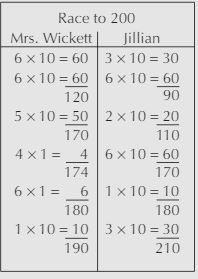How do you combine computation skills and a game in the same setting? The game Race to 200 helps students, and their partners, build their understanding of number computation, number sense, and place value. This game can be played during one class period, but we recommend trying all three versions, over three periods, so students can increase rigor and stay challenged. The object of the game is to be the player with the score closest to 200.
Materials needed:
- base ten blocks in zip-top baggies, each with 30 ones cubes, 25 longs, and 4 flats, 1 per pair of students
- dice, 1 per pair of students for Day 1; then 2 per pair of students
- optional: Base Ten Blocks sheets cut out and placed in zip-top baggies, 1 per pair of students
- optional: rules for Race to 200, 1 per pair of students
Time
Three Class periods
The rules:
- Each player must take 6 turns.
- On your turn, roll the die. You may take ones or tens. The die tells you how many.
- Both players must record all turns. Add the total for each turn to the previous score.
- After each player has taken six turns, compare scores to see whose score is closer to 200 and record underneath the chart.
- The player with the score closer to 200 wins. (Note: ties are possible but rare)
Day One
Introduce the name and the rules of the game to your class, writing both on the board. Before beginning the game with the entire class, play the game with a student in front of the class, so students can see the game in action and ask questions along the way. Draw a T-chart on the board with your name on one side, and the students(or partners) name on the other. Now you can begin the game! Here is an example of how the game should look:
Everyone must take six turns, on the roll of the die, you can either take ones or tens. Both players will record scores, and add them to the previous score. At the end of the game, all students must summarize their and their partners’ total scores, who won, and how many they won by.
As you can see, Mrs. Wickett and Jillian’s scores are both 10 away from 200. Mrs. Wickett is under, Jillian is over. Make sure to stress that going over 200 is okay. The only object of the game is who can get closest to 200. Since both players are 10 points away this is a tie.
Now, Mrs. Wickett and Jillian must both explain each other’s scores and who won on the bottom of the board (or score keeping sheets). Here is an example:
Day Two
The same rules still apply. The only difference in this version is that students must now use dice, instead of a die, and add the two numbers up and decide whether to take ones or tens. Students will roll the dice on their turn and must add them up for a total number, and then decide whether to take ones or tens.
Students should play the game a few times, this can give them opportunities to try different methods and learn from different strategies. When pairs begin to finish the game, ask them what they learned if they had a strategy, and how they would have played differently, or if they would have made different decisions. Students should still take the time to create their summary at the end of the game, like the example above.
Day Three
This period should focus on strategy. Express to students the importance of strategies, asking them to recall their previous games, and evaluate what worked and what didn’t work. Did taking all tens works? Or all ones? How did they make their decisions?
Visit a few groups and ask students how they are doing and why they chose tens over ones or vice versa.
Class Discussion
After playing Race to 200 over the past three periods, or days, take the time to lead a class discussion. Give students time to reflect on their previous games with their score sheets. Do they recognize any patterns or instances that helped them meet their objective of reaching 200?
- Did students choose tens on all their rolls?
- Did students take ones first?
- How did they decide who was closer to 200?
- What might they have done differently?

 All Blog Posts
All Blog Posts


Comments